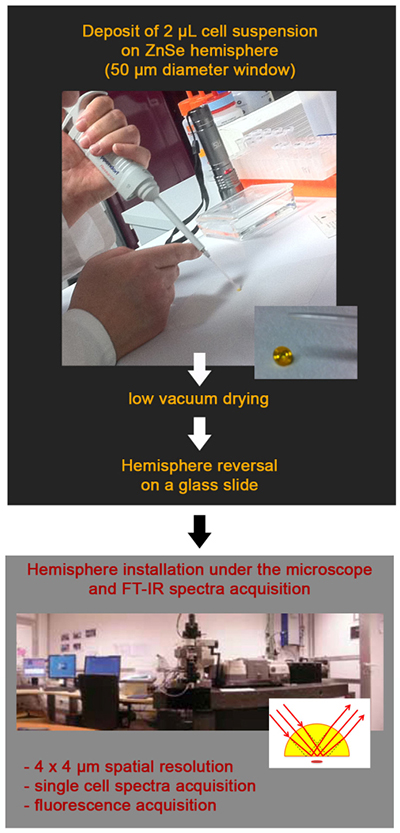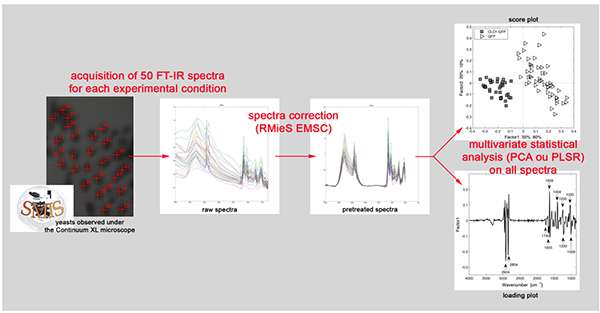Combination of SMIS beamline synchrotron radiation and ZnSe hemisphere has allowed INRA researchers to obtain single yeast infrared spectra. The comparative analysis of infrared spectra of yeasts with a high or low oil content revealed major metabolism variations between strains with a variable lipid storage capacity. This work sheds light on the cellular mechanisms operating when oil is stored, in order to develop efficient yeasts for green chemistry applications.
Yeast oils, biodiesel and green chemistry
Yeasts have been used for centuries in biotechnological applications, for food processing industry (wine, beer, cider, bread, cheese, etc.). For the past few decades, they have also been studied with the aim of producing oil to replace fossil resources. Some yeasts are ‘oleaginous’, meaning that they can produce up to 80% of their mass in oil (or storage lipids). This oil can then be transformed into biodiesel or precursors for green chemistry. The main objectives for the development of yeasts for massive oil production are: (i) to increase yield, (ii) to modify the profiles of the fatty acids contained in oils, to satisfy technical requirements and conditions of use. For example, derivatives of polyunsaturated fatty acids (PUFA) are used in the production of plastics and polymers. The same is true for medium-chain fatty acids (carbon number between 6 and 14), which are precursors for the production of cleaning products, lubricants, and cosmetics.
The cell exposed by infrared
It is in this context that, the DYSCOL ('Dynamics and Structure of Lipid Bodies’ in French) team at the Jean-Pierre Bourgin Institute (INRA-AgroParisTech, Versailles) performed its research. The team is aiming at identifying the factors that affect the quantity and quality of oils produced in plants and micro-organisms. Through a genetic modification of baking yeast (S. cerevisiae), i.e.the expression of proteins involved in oil storage in plant seeds, researchers obtained strains able to produce more storage lipids. To better understand the mechanisms involved in oil accumulation in these yeasts, the scientists analysed these strains and control strains (with low oil content) by infrared microscopy (Fourier Transformed Infrared, FT-IR). This technique provides an overview of the cellular metabolism thanks to a spectral fingerprint of biological macromolecules (lipids, nucleic acids, sugars, etc.). FT-IR can replace traditional biochemical tests, which use large quantities of biomass and solvents. This means that large populations can be tested (high output approaches). Combined with the high spectral and spatial resolution offered by synchrotron light, FT-IR can be used for an analysis at the single cell scale, for statistical and population heterogeneity analyses.
From test tube to spectrum: presentation of an integrated approach
Thanks to the presence of the biology lab in the SOLEIL facility, the scientists have been able to develop a protocol allowing the FT-IR analysis of freshly-sampled cells at different growth times (1 Day = 18 hours and 2 days = 42 hours). This means that the cells could be sampled, concentrated by centrifugation, and then washed in water just few minutes prior to the observations. A drop of the cell suspension was dried on a selenium zinc (ZnSe) ATR hemisphere 4 mm in diameter. The spectra were recorded using the Continuum XL microscope available on the SMIS beamline, with a spatial resolution of 4x4 µm, which is the mean size of a cell. The spectra were then analysed by computer software (spectrum correction and statistical analyses) to evaluate spectrum variations between strains.
Carbohydrates or lipids—make a choice!
The researchers have shown that an increase in oil content leads to significant metabolic changes, in particular on carbon pools. An inverse correlation between oil content and carbohydrates reserves (glycogen) was revealed. These results help to direct the research program of the DYSCOL team. by. This inverse correlation between storage lipids and storage carbohydrates has been confirmed by biochemical analysis. Transcriptomics is now in progress to identify regulators and cellular mechanisms involved in the storage of storage lipids, with the aim of obtaining high-performance yeasts for biotechnological applications.

Figure 1: views of the SMIS beamline and the deposit on the hemisphere

Figure 2: Data acquisition and processing chain.
